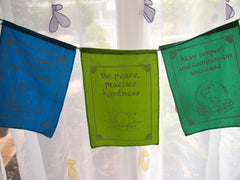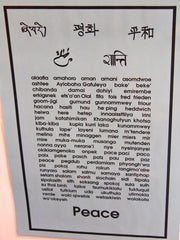The International Montessori Congress provided a great deal of inspiration on a broad range of topics. There were so many insightful and intelligent keynote speakers and workshop presenters; by the end of the event I felt almost overwhelmed by all the emotion and information that I had absorbed!
Since my return to Australia I have been processing my experiences by reflecting on both my memories and my notes from the event. In the spirit of the Congress theme - 'Guided by Nature' - I had used my iPad rather than paper to take my notes. So I had plenty of photos and digital notes to review and help remind me of the powerful messages I had heard and the important plans I had been inspired to make.
One of the first plans that I put into action was the development of a Peace Table in my Montessori classroom. This is actually something that was on my To-Do List before going to the Congress (in fact, it's even included on our official Quality Improvement Plan!). I am ashamed to say, however, that it had languished on the list for far too long as other projects took my attention. It is not that these other projects were more important, they simply seemed more urgent. Yet the Congress filled me with a sense of urgency about the concept of peace. Many of the speakers shared a common emphasis on how important it is that we, as Montessori educators or parents, remember that we are not merely 'teaching' but guiding the child into the world. We are having an impact on how these developing humans view their world. We provide the experiences that help to shape their impressions of nature, of people, of society and of the earth as a home to countless complex and wondrous concepts.
So when I arrived home from the Congress it seemed urgent to me to get our Peace Table ready!

A Peace Table is a place that promotes active reconciliation between children, encourages a sense of inner-harmony and inspires a cohesive community.
The significance of the Peace Rose at a Peace Table relates to the idea of a symbol of peace being used during a process of expressing feelings and seeking solutions. Each child takes turns holding the rose so that he or she is free to express their feelings without the fear of interruption (as the other child waits for the rose before he or she can respond).
Our Peace Table is, in many ways, quite simple. Yet its purpose is immensely powerful and I was eager to seek symbols to represent the importance of the restorations that would occur here. So our Globe, some pewter doves and the story of The Peace Rose were arranged together (along with a small artificial rose, so that even on the occasions where our living roses had wilted there would still be an available alternative!).
The table is framed by a mirror. This is intended to provide a symbolic reminder of the presence of the "self" in any process of peace. This emphasises that the first step on the path of peace is for the individual to make an active decision to strive for this state; whether that means meditating quietly as an individual, to reach 'inner peace', or engaging in reconciliation after a conflict with a peer.
The table is deliberately set without chairs. We were aware that placing a chair (or chairs) at the table would immediately imply a limit to the experience. If we put one chair at the table then it would actually create a potential source for continued conflict, as two anxious children who are looking to make peace would have to battle for the right to sit first. If we placed two chairs at the table then it would appear that only two people can be involved in a conflict or the resulting restoration. By leaving the table without chairs we are able to empower the children to make choices about their peace process. They can choose how many people are present at the reconciliation, and each participant can decide where he or she feels comfortable to sit or stand.


Around our table we have decorated the environment with further symbols of peace. A set of flags hang like bunting over the window above the Peace Table. Each flag features a different pictorial and a linguistic expression of peace. Beside the table we also proudly display a poster inscribed with translations of the word 'Peace' from various languages from across the earth. This communicates the concept that peace is universal. It might begin in our classroom but it develops within our hearts and spreads across the globe!

We decided to add a little sign to outline the purpose of our Peace Table. The majority of the children in our classroom are unable to read these words independently, but their presence is powerful nonetheless. It ensures that every adult who enters our classroom has an immediate introduction to our approach to peace. One of these adults can act as a guide for new children (or children new to the Peace Table) by reading these words...
A safe place to express feelings, resolve conflict and reinstate a sense of peace and harmony in our classroom community.
Please use this table as a quiet place to meditate if you are seeking inner peace.
I know the impact that these words, and this table, can have in the classroom...and I can't help but wonder whether other environments would benefit from these tools. Should each office contain a special area set aside as a Peace Table? A place to confront conflict, express emotion, seek solutions and repair relationships.
How about the home? Surely siblings fight, and require guidance on how to restore harmony after these conflicts...but perhaps the best guidance would be role modelling. Husbands and wives, co-parents and partners succumb to conflict sometimes too. We debate, or disagree, or fight. Most attempt to 'protect' the children from these experiences but in reality most little eyes and ears will see and hear conflict between the adults in the home. Yet do they see the resolution? The 'I'm sorry' or 'Now I understand' or the 'I still don't agree with you, but now I can see where you're coming from and I'm sorry about how I reacted' tend to occur much later and usually in private. These resolutions are quiet words shared across the chasm of the bed as two partners face opposite directions, or from one mobile phone to another at lunchtime when the heat of the morning's argument has cooled off. So the children who may have witnessed the conflict are unaware of the resolution, and unsure about whether harmony has been restored to the home. So perhaps a Peace Table at home would be a quite reminder for the adults to intentionally exhibit their process of relational rehabilitation.
We don't stock it at Montessori Child for a couple of reasons. One is that due to the high costs of importing books we would not be able to offer reasonable prices to our families, and we don't feel comfortable charging you higher prices when we know it is available elsewhere at a lower cost. The other reason that we avoid stocking books is that we respect the position of 'Montessori Books' in the Australian Montessori community and we don't wish to infringe upon them. At the time of writing this blog Montessori Books is not stocking the Peace Rose but they have in the past and hopefully will again soon!




The Lion Who Wanted to Love, by Giles Andreae (one of my personal heroes!), is a book that genuinely moves me every time I read it. Each time that I reach the emotional climax of the story I start to experience the feeling of tears stinging my eyes. This story is beautifully written and extremely engaging for Pre-schoolers but it also subtly handles several high-level concepts; accepting differences in others, showing empathy, reciprocal relationships, altruism and peace.
(There is only one other children's book that has a greater emotional influence on me; the classic story 'Love You Forever'. I am incapable of getting through that story without full-blown, unabashed crying.)
It is never too early to start thinking peacefully, so for infants and toddlers there is Ten Little Fingers and Ten Little Toes by Mem Fox. A simple story, with that lovely repetition that tiny ones love, it sows the seeds of peace by establishing that we share a common thread with all people across the world.
Mem Fox strikes another blow for peace (pardon the irony!) with Whoever You Are. Another gorgeously crafted text, with the child-friendly ingredients of rhythm, rhyme and repetition. This is another book that always stirs up my emotions as it reminds us that whoever you are there are others like you all around the world who smile, cry, bleed and love just as you do!
Finally, there is a powerful story that my mum gave to me and my brother when we were little. Peacetimes, by Katherine Scholes, delves much more deeply and directly into the concept of peace. It is a resource for older children who are going through that 'second plane of development' and are consciously considering morality and ethics. Primary school children - between the (approximate) ages of 6 to 12 - are extremely socially focused and start to talk about equity and fairness (if you have two children in this plane of development you will hear endless debates about whether or not something is "fair"!). It is a beautiful period but it requires a lot of support, patience and the provision of useful resources. Peacetimes is an ideal addition to your toolkit as it guides the child through a journey of understanding the importance of peace, in terms of both an internal perspective and a global context.
There are surely countless other stories that offer children a piece of peace. There are also many symbols, experiences, conversations and provokations that you can offer to children to help them come to terms with this complex but immeasurably valuable concept. I hope that you - and the children in your care - enjoy creating your own path to peace.
While preparing this post I went searching on YouTube for a video of these books being read aloud. There were a few options available but didn't seem to engage or convey emotion in quite the way I was looking for. So the downside is that I have no videos to embed here...but the upside is that it has planted the seeds for a future blog post on: The Art of Reading Aloud.

1 comment
Feb 04, 2018 • Posted by Melony
Dear Jessica
I, too, had a beautiful peace table in my former 9-12 environment and with moving on, I now want to set up a new one.
After reading your “Peace Table Quote” I’m so keen to use it verbatim. Would you mind if I did?
Melony- O’Summit Montessori Gauteng, South Africa
Leave a comment: